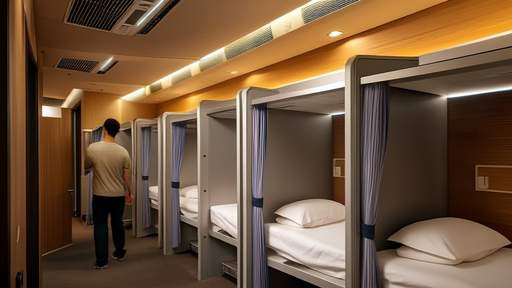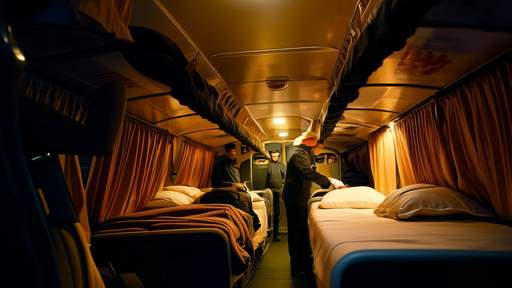The humid night air clung to the windows as the sleeper bus rolled into the terminal in Hanoi. Passengers stretched their limbs after the long journey, unaware of the meticulous cleaning ritual about to unfold. In Vietnam's extensive network of overnight buses, where travelers spend hours curled in narrow berths, sanitation has become both an art and a science.
Behind the scenes, crews work with military precision during the 40-minute turnover between routes. What appears as simple bed-making masks a rigorous decontamination process developed through years of trial and error. The vinyl-covered mattresses tell the story - while they show years of use, their surfaces gleam with recent disinfection.
Teams begin by stripping each berth down to its plastic skeleton. Sheets and blankets disappear into color-coded laundry bags, destined for industrial washing at temperatures that would make most fabrics shrink. The real work starts when the cleaning carts arrive, stocked with solutions that would look at home in a hospital corridor.
A sharp citrus scent cuts through the bus interior as workers spray the first antimicrobial layer. They pay particular attention to the concave spaces where bodies leave impressions - these human-shaped depressions become breeding grounds for microbes during overnight journeys. The cleaning process follows an unwritten topography: headrests receive triple attention, curtain handles get double wipes, and air vents undergo compressed air blasts.
Between the bunks, narrow aisles become obstacle courses for cleaners wielding UV wands. These handheld devices emit an eerie blue glow as they pass over surfaces, neutralizing pathogens invisible to the naked eye. The technology, once exclusive to medical facilities, has become commonplace in Vietnam's transportation sector since the pandemic.
Seasoned cleaners develop an almost intuitive sense for trouble spots. The folding trays between berths, fingered by dozens of passengers daily, undergo a specialized four-step process. First comes the degreaser for food residue, followed by disinfectant, then a pH-balancing rinse, and finally a food-safe drying agent. The metal surfaces end up so sterile they temporarily lose their characteristic smell.
Curtains present their own challenges. While they receive machine washing between routes, the midday sun becomes an additional sanitizing agent. Workers stretch the freshly laundered fabrics across specially designed racks that expose both sides to ultraviolet radiation. By the time they're rehung, the fabrics have undergone what amounts to a full-scale microbial reset.
The final touch comes from an unexpected source - locally sourced bamboo charcoal pouches placed discreetly in each berth. These traditional odor absorbers, now backed by scientific studies showing their antibacterial properties, serve as the last line of defense against stale air. Their presence reflects the blend of ancient wisdom and modern technology that characterizes Vietnam's approach to transit hygiene.
As new passengers board, they encounter beds that feel paradoxically both broken-in and clinical. The vinyl has lost its stiff newness through years of use, yet carries none of the stickiness or odors typically associated with heavily used surfaces. Those sensitive to smells might detect a faint medicinal tang beneath the citrus - the signature of industrial-grade disinfectants doing their work.
This nightly ritual plays out across hundreds of vehicles nationwide, creating what amounts to a rolling sanitation network. The protocols continue evolving, with some companies experimenting with antimicrobial mattress coatings and others testing ozone generators during overnight parking. What remains constant is the understanding that in close-quarter travel, visible cleanliness matters less than the invisible work of pathogen control.
Foreign travelers often remark on the contrast between the buses' worn exteriors and hygienic interiors. The dichotomy speaks to Vietnamese priorities - where mechanical reliability and sanitation trump cosmetic appearances. As the global transportation industry grapples with post-pandemic standards, these unassuming sleeper buses offer unexpected lessons in practical biosecurity.
The next wave of innovation may come from an unlikely source: the drivers themselves. Through years of observation, many have developed folk methods for maintaining freshness - from strategically placed herbs to precise ventilation sequences during cleaning. Transport companies have begun systematically collecting these grassroots solutions, creating a living database of best practices that blends laboratory science with road-tested wisdom.
As dawn breaks over the next terminal, another cycle begins. The cleaning crews move with the quiet efficiency of those who know their work protects not just comfort, but public health. In a country where sleeper buses form the backbone of long-distance travel, the humble bunk's sterilization has become a matter of national importance.

By /Jun 5, 2025

By /Jun 5, 2025

By /Jun 5, 2025

By /Jun 5, 2025

By /Jun 5, 2025

By /Jun 5, 2025

By /Jun 5, 2025

By /Jun 5, 2025

By /Jun 5, 2025

By /Jun 5, 2025

By /Jun 5, 2025

By /Jun 5, 2025

By /Jun 5, 2025

By /Jun 5, 2025

By /Jun 5, 2025

By /Jun 5, 2025

By /Jun 5, 2025

By /Jun 5, 2025

By /Jun 5, 2025

By /Jun 5, 2025